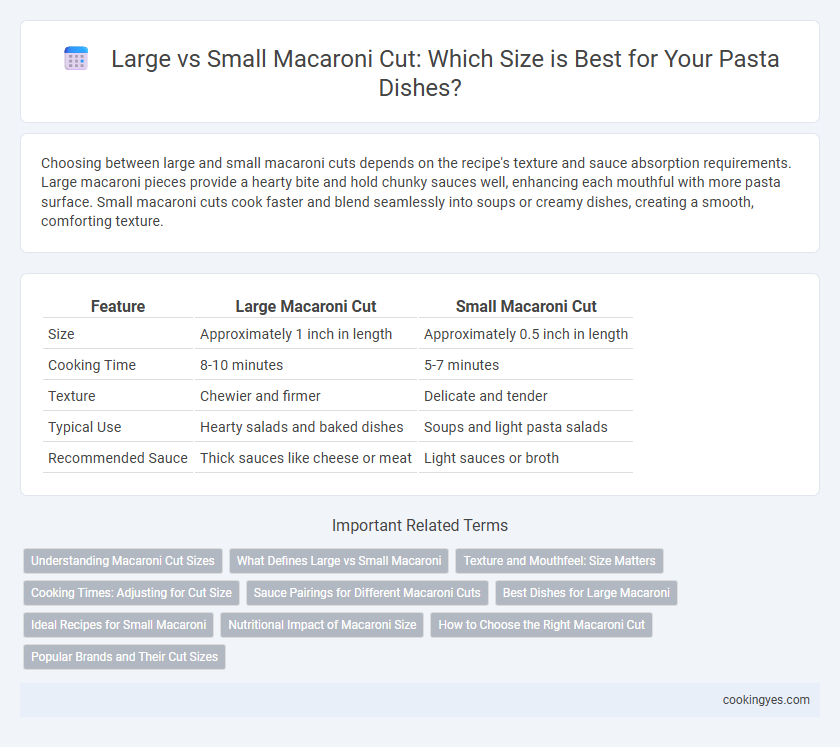Choosing between large and small macaroni cuts depends on the recipe's texture and sauce absorption requirements. Large macaroni pieces provide a hearty bite and hold chunky sauces well, enhancing each mouthful with more pasta surface. Small macaroni cuts cook faster and blend seamlessly into soups or creamy dishes, creating a smooth, comforting texture.
Table of Comparison
| Feature | Large Macaroni Cut | Small Macaroni Cut |
|---|---|---|
| Size | Approximately 1 inch in length | Approximately 0.5 inch in length |
| Cooking Time | 8-10 minutes | 5-7 minutes |
| Texture | Chewier and firmer | Delicate and tender |
| Typical Use | Hearty salads and baked dishes | Soups and light pasta salads |
| Recommended Sauce | Thick sauces like cheese or meat | Light sauces or broth |
Understanding Macaroni Cut Sizes
Macaroni cut sizes vary primarily between large and small, influencing cooking time and texture; larger cuts require longer boiling to achieve the perfect al dente firmness, while smaller cuts cook faster and offer a tender bite. Understanding these size differences helps in selecting the appropriate macaroni for specific recipes, such as baked dishes favoring larger cuts to hold fillings or soups needing smaller cuts for easy spooning. Precise cut size knowledge enhances culinary results by balancing cooking efficiency with desired mouthfeel.
What Defines Large vs Small Macaroni
Large macaroni is defined by its wider diameter, typically exceeding 1/4 inch, allowing for a thicker, more substantial pasta bite, while small macaroni usually measures below this threshold, offering a more delicate texture. The cut size impacts cooking time and sauce retention, with larger macaroni better suited for hearty, chunky sauces and smaller varieties ideal for lighter, creamier preparations. Manufacturers often categorize macaroni sizes based on these dimensions to align with specific culinary uses and consumer preferences.
Texture and Mouthfeel: Size Matters
Large macaroni cuts provide a heartier texture with a chewy bite that enhances meat-based sauces and thick cheese blends, creating a satisfying mouthfeel in every forkful. Small macaroni pieces offer a smoother, creamier texture that blends seamlessly into soups and lighter sauces, making each spoonful delicate and easy to eat. Size directly impacts how the pasta holds sauce and interacts with other ingredients, influencing the overall texture and dining experience.
Cooking Times: Adjusting for Cut Size
Large macaroni cuts require longer cooking times, typically around 12 to 15 minutes, to achieve a tender texture without becoming mushy. Small macaroni pieces cook faster, usually in 7 to 10 minutes, allowing for quicker preparation and more precise control over firmness. Adjusting cooking times based on macaroni size ensures optimal texture and prevents under- or overcooking in pasta dishes.
Sauce Pairings for Different Macaroni Cuts
Large macaroni cuts like elbow or cavatappi are ideal for thick, hearty sauces such as meat ragu or creamy cheese blends because their ample surface area captures rich textures effectively. Small macaroni cuts, like ditalini or small shells, pair best with lighter, broth-based sauces or simple tomato blends, as their size allows quick coating and easy consumption in soups or salads. Selecting the right macaroni size enhances the harmony between pasta texture and sauce consistency, elevating the overall flavor experience.
Best Dishes for Large Macaroni
Large macaroni cuts are ideal for hearty dishes such as baked casseroles, mac and cheese, and pasta salads, where their size allows for better sauce retention and a more substantial bite. Unlike smaller macaroni shapes, large macaroni holds chunky ingredients and cheese blends effectively, enhancing texture and flavor. Recipes like classic American baked macaroni and cheese benefit from large macaroni's ability to evenly distribute rich sauces and melted cheese throughout each piece.
Ideal Recipes for Small Macaroni
Small macaroni cuts are ideal for creamy pasta salads, soups, and baked casseroles where their compact size allows for even sauce distribution and easy biting. Recipes like macaroni and cheese or minestrone soup benefit from small macaroni's ability to hold rich, cheesy sauces and absorb flavorful broths effectively. Choosing small macaroni enhances texture and flavor balance in dishes requiring delicate pasta pieces that blend seamlessly with other ingredients.
Nutritional Impact of Macaroni Size
Large macaroni cuts tend to have a slightly lower glycemic index compared to smaller shapes due to slower digestion and absorption rates, impacting blood sugar levels more gradually. Smaller macaroni pieces have a higher surface area-to-volume ratio, which can result in faster cooking and more rapid starch breakdown, potentially affecting the carbohydrate availability. While the overall macronutrient content remains consistent, portion control and cooking methods influenced by macaroni size can affect the nutritional impact on calorie intake and digestion.
How to Choose the Right Macaroni Cut
Selecting the right macaroni cut depends on the dish's texture and sauce absorption; large macaroni holds thicker sauces and provides a chewier bite, ideal for baked dishes or hearty sauces. Small macaroni, with its compact size, evenly coats lighter sauces and is perfect for soups or pasta salads where a delicate texture is preferred. Consider the sauce viscosity and desired mouthfeel when choosing between large and small macaroni cuts to enhance overall flavor and presentation.
Popular Brands and Their Cut Sizes
Popular macaroni brands like Barilla and De Cecco offer a variety of cut sizes, with Barilla typically emphasizing smaller elbow-shaped macaroni around 1 inch in length, while De Cecco provides larger tubes often measuring up to 1.5 inches. These differences in cut size influence cooking times and sauce absorption, with smaller macaroni favored for creamy dishes and larger cuts preferred in baked recipes. Consumer preferences often lean towards the smaller cuts for quick meals, whereas gourmet recipes commonly call for the robustness of larger macaroni cuts from premium brands.
Large vs Small for Macaroni Cut Infographic

 cookingyes.com
cookingyes.com